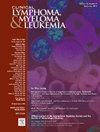Stem Cell Mobilization Yields with Daratumumab (Dara) and Lenalidomide (Len)-Containing Quadruplet Induction Therapy in Patients with Newly Diagnosed Multiple Myeloma (NDMM): A Real-World Experience at 2 Institutes
IF 2.7
4区 医学
Q2 HEMATOLOGY
引用次数: 0
Abstract
Background
Quadruplet therapy has become standard frontline therapy in transplant eligible NDMM patients. Using data from the MASTER and GRIFFIN trials, Chhabra et al. reported that Dara-Len containing quadruplet therapies had minimal impact on stem cell harvesting and engraftment. It is unclear if this remains true in a real-world setting where heterogeneity exists among patients and in institutional practices. Herein, we describe our experience of stem cell mobilization and collection in NDMM patients receiving DRVd at Levine Cancer Institute (LCI) and Emory Winship Cancer Institute.
Methods
In this multi-center retrospective analysis, NDMM patients were eligible if they received DRVd and pursued stem cell collection between September, 2019 and January, 2024 at LCI and January, 2019 and July, 2022 at Emory. Patients either received 10 mcg/kg of growth colony-stimulating factor (G-CSF) daily (LCI) or 7.5 mcg/kg twice daily (Emory) for 4 days prior to collection and 1 dose on the morning of apheresis. Plerixafor was provided on day -1 of apheresis as a preemptive mobilization strategy at LCI and on an as needed basis at Emory. Patients with a suboptimal stem cell yield on day 1 received additional doses of G-CSF with or without rescue plerixafor at both sites followed by a second day of stem cell collection. Stem cell yield failure was defined as the inability to achieve a minimal goal dose of 2.0 × 106 cells/kg. Categorical outcomes were summarized with frequencies and proportions while numerical outcomes were summarized with descriptive statistics. Select data elements were only available in the LCI cohort.
Results
A total of 423 patients were analyzed. The median patient age was 62 years (range, 23-79), and 38.1% of the cohort was African American. Thirteen percent of the cohort had high risk cytogenetics and 19.1% had ISS stage III disease. At LCI, patients received a median of 4 (range, 1-14) cycles of induction therapy before stem cell collection. In the entire cohort, 88.8% of patients received 21-day cycles and 11.2% received 28-day cycles. Most patients achieved a VGPR or better (87.2%) after induction and, of those with MRD data available at LCI, 41.6% (37 of 89) achieved MRD negative status (at 10-5). Of those with available data (n = 92), stem cell collection occurred after a median of 4 weeks (range, 2 to 8) from induction completion. All patients at LCI and 308 of the 318 (96.9%) patients at Emory received plerixafor. Among the entire cohort, the median number of total CD34+ cells collected was 9.0 × 106 CD34+ cells/kg (range 0-24.1). By institute, the median number of CD34+ cells across all attempts at LCI was 8.5 × 106 CD34+ cells/kg (range 2.9-18.1) and the median at Emory was 9.0 × 106 CD34+ cells/kg (0-24.1) indicating that there was no significant difference between mobilization strategies (P = .088). There also was no significant difference in stem cell yield between the 21-day and 28-day cycles; median yield was 9.0 × 106 CD34+ cells/kg versus 8.6 × 106 CD34+ cells/kg, respectively (P = .246). About 94.3% (N = 397) of patients collected enough for 2 transplants. Only 2.8% (12 of 423) required an additional mobilization attempt to achieve the minimal target stem cell yield. In the entire population, there was 1 mobilization failure (0.2%) and all but 1 patient who required remobilization collected sufficient stem cells.
Conclusion
The addition of Dara to RVd induction therapy led to impressive hematologic responses and did not have a deleterious effect on stem cell mobilization with an upfront plerixafor strategy. The median stem cell yield in this real-world experience was slightly better than that reported in the GRIFFIN trial.
含有达拉单抗(Dara)和来那度胺(Len)的四联体诱导治疗对新诊断的多发性骨髓瘤(NDMM)患者的干细胞动员产量:两个研究所的真实世界经验
背景:四联体治疗已成为符合移植条件的NDMM患者的标准一线治疗。Chhabra等人利用MASTER和GRIFFIN试验的数据报道,含有四联体的Dara-Len疗法对干细胞采集和移植的影响最小。目前尚不清楚,在患者和机构实践中存在异质性的现实环境中,这是否仍然是正确的。在此,我们描述了我们在Levine癌症研究所(LCI)和Emory Winship癌症研究所接受DRVd的NDMM患者中干细胞动员和收集的经验。方法:在这项多中心回顾性分析中,如果NDMM患者在LCI(2019年9月至2024年1月)和Emory(2019年1月至2022年7月)接受DRVd并进行干细胞收集,则符合条件。患者在采集前4天每天接受10微克/千克生长集落刺激因子(G-CSF) (LCI)或每天两次接受7.5微克/千克(Emory),并在采血早晨接受1剂。Plerixafor在采血的第一天提供,作为LCI的先发制人的动员策略,并根据需要在Emory提供。在第1天干细胞产量不理想的患者在两个部位接受额外剂量的G-CSF,加用或不加救用plerixafor,然后在第二天收集干细胞。干细胞产量失败被定义为无法达到2.0 × 106个细胞/kg的最小目标剂量。分类结果用频率和比例进行总结,数值结果用描述性统计进行总结。所选数据元素仅在LCI队列中可用。结果:共分析423例患者。患者的中位年龄为62岁(范围23-79岁),38.1%的队列是非裔美国人。该队列中13%的人具有高危细胞遗传学,19.1%的人患有ISS III期疾病。在LCI,患者在干细胞收集前接受中位4(范围1-14)个周期的诱导治疗。在整个队列中,88.8%的患者接受21天周期治疗,11.2%接受28天周期治疗。大多数患者在诱导后达到了VGPR或更好(87.2%),在LCI有MRD数据的患者中,41.6%(89人中有37人)达到了MRD阴性状态(10-5)。在有可用数据的患者中(n = 92),干细胞收集发生在诱导完成后中位4周(范围2至8周)。LCI的所有患者和Emory的318例患者中的308例(96.9%)接受了plerixafor。在整个队列中,收集到的CD34+细胞总数中位数为9.0 × 106个/kg(范围0-24.1)。在研究所,在LCI的所有尝试中,CD34+细胞的中位数为8.5 × 106 CD34+细胞/kg(范围为2.9-18.1),Emory的中位数为9.0 × 106 CD34+细胞/kg(0-24.1),表明两种动员策略之间没有显著差异(P = 0.088)。在21天和28天的周期中,干细胞产量也没有显著差异;中位产率分别为9.0 × 106 CD34+ cells/kg和8.6 × 106 CD34+ cells/kg (P = 0.246)。约94.3% (N = 397)的患者收集到足够进行2次移植。只有2.8%(423例中的12例)需要额外的动员尝试来达到最小的目标干细胞产量。在整个人群中,有1例动员失败(0.2%),除了1例需要重新动员的患者外,所有患者都收集了足够的干细胞。结论:在RVd诱导治疗中添加Dara可产生令人印象深刻的血液学反应,并且对前置plerixafor策略的干细胞动员没有有害影响。真实世界中干细胞产量的中位数比GRIFFIN试验中报道的稍好。
本文章由计算机程序翻译,如有差异,请以英文原文为准。
求助全文
约1分钟内获得全文
求助全文
来源期刊

Clinical Lymphoma, Myeloma & Leukemia
ONCOLOGY-HEMATOLOGY
CiteScore
2.70
自引率
3.70%
发文量
1606
审稿时长
26 days
期刊介绍:
Clinical Lymphoma, Myeloma & Leukemia is a peer-reviewed monthly journal that publishes original articles describing various aspects of clinical and translational research of lymphoma, myeloma and leukemia. Clinical Lymphoma, Myeloma & Leukemia is devoted to articles on detection, diagnosis, prevention, and treatment of lymphoma, myeloma, leukemia and related disorders including macroglobulinemia, amyloidosis, and plasma-cell dyscrasias. The main emphasis is on recent scientific developments in all areas related to lymphoma, myeloma and leukemia. Specific areas of interest include clinical research and mechanistic approaches; drug sensitivity and resistance; gene and antisense therapy; pathology, markers, and prognostic indicators; chemoprevention strategies; multimodality therapy; and integration of various approaches.
 求助内容:
求助内容: 应助结果提醒方式:
应助结果提醒方式:


